COIT20249 Robotics Report
VerifiedAdded on 2019/09/16
|11
|5359
|344
Report
AI Summary
This document outlines the requirements for a report on robotics for the COIT20249 course. The report requires students to analyze a case study scenario about the use of robotics in a fictional company and make recommendations for its strategic plan. The report must adhere to specific formatting and referencing guidelines, including APA style, and must include an executive summary, table of contents, introduction, body, conclusion, and recommendations. The assessment criteria include the quality of the executive summary, table of contents, introduction, body, conclusion, recommendations, organization, presentation, references, and length. The report must be between 2250 and 2750 words, and late submissions will incur a penalty. The document also provides a detailed marking rubric for the report.
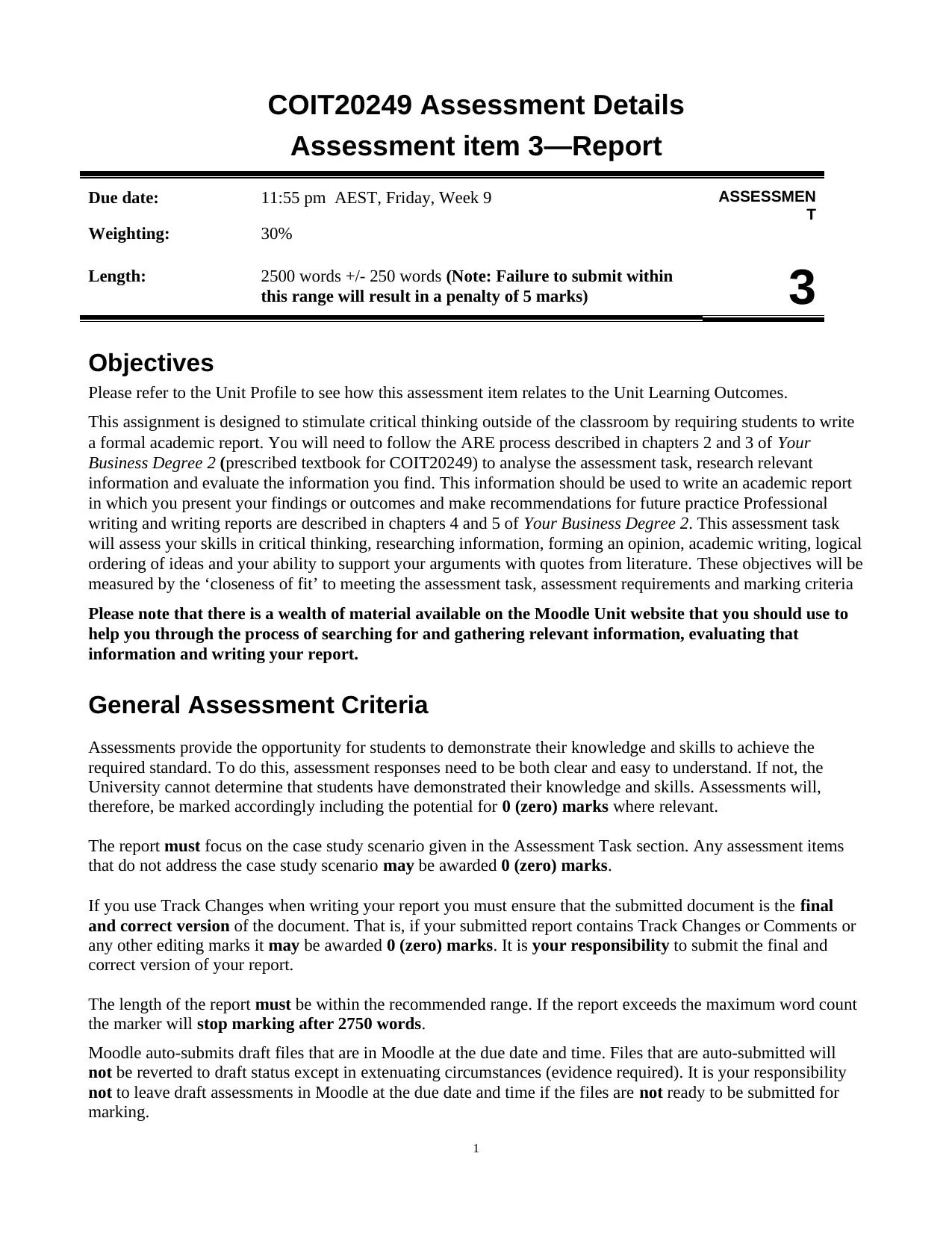
COIT20249 Assessment Details
Assessment item 3—Report
Due date: 11:55 pm AEST, Friday, Week 9 ASSESSMEN
T
Weighting: 30%
3Length: 2500 words +/- 250 words (Note: Failure to submit within
this range will result in a penalty of 5 marks)
Objectives
Please refer to the Unit Profile to see how this assessment item relates to the Unit Learning Outcomes.
This assignment is designed to stimulate critical thinking outside of the classroom by requiring students to write
a formal academic report. You will need to follow the ARE process described in chapters 2 and 3 of Your
Business Degree 2 (prescribed textbook for COIT20249) to analyse the assessment task, research relevant
information and evaluate the information you find. This information should be used to write an academic report
in which you present your findings or outcomes and make recommendations for future practice Professional
writing and writing reports are described in chapters 4 and 5 of Your Business Degree 2. This assessment task
will assess your skills in critical thinking, researching information, forming an opinion, academic writing, logical
ordering of ideas and your ability to support your arguments with quotes from literature. These objectives will be
measured by the ‘closeness of fit’ to meeting the assessment task, assessment requirements and marking criteria
Please note that there is a wealth of material available on the Moodle Unit website that you should use to
help you through the process of searching for and gathering relevant information, evaluating that
information and writing your report.
General Assessment Criteria
Assessments provide the opportunity for students to demonstrate their knowledge and skills to achieve the
required standard. To do this, assessment responses need to be both clear and easy to understand. If not, the
University cannot determine that students have demonstrated their knowledge and skills. Assessments will,
therefore, be marked accordingly including the potential for 0 (zero) marks where relevant.
The report must focus on the case study scenario given in the Assessment Task section. Any assessment items
that do not address the case study scenario may be awarded 0 (zero) marks.
If you use Track Changes when writing your report you must ensure that the submitted document is the final
and correct version of the document. That is, if your submitted report contains Track Changes or Comments or
any other editing marks it may be awarded 0 (zero) marks. It is your responsibility to submit the final and
correct version of your report.
The length of the report must be within the recommended range. If the report exceeds the maximum word count
the marker will stop marking after 2750 words.
Moodle auto-submits draft files that are in Moodle at the due date and time. Files that are auto-submitted will
not be reverted to draft status except in extenuating circumstances (evidence required). It is your responsibility
not to leave draft assessments in Moodle at the due date and time if the files are not ready to be submitted for
marking.
1
Assessment item 3—Report
Due date: 11:55 pm AEST, Friday, Week 9 ASSESSMEN
T
Weighting: 30%
3Length: 2500 words +/- 250 words (Note: Failure to submit within
this range will result in a penalty of 5 marks)
Objectives
Please refer to the Unit Profile to see how this assessment item relates to the Unit Learning Outcomes.
This assignment is designed to stimulate critical thinking outside of the classroom by requiring students to write
a formal academic report. You will need to follow the ARE process described in chapters 2 and 3 of Your
Business Degree 2 (prescribed textbook for COIT20249) to analyse the assessment task, research relevant
information and evaluate the information you find. This information should be used to write an academic report
in which you present your findings or outcomes and make recommendations for future practice Professional
writing and writing reports are described in chapters 4 and 5 of Your Business Degree 2. This assessment task
will assess your skills in critical thinking, researching information, forming an opinion, academic writing, logical
ordering of ideas and your ability to support your arguments with quotes from literature. These objectives will be
measured by the ‘closeness of fit’ to meeting the assessment task, assessment requirements and marking criteria
Please note that there is a wealth of material available on the Moodle Unit website that you should use to
help you through the process of searching for and gathering relevant information, evaluating that
information and writing your report.
General Assessment Criteria
Assessments provide the opportunity for students to demonstrate their knowledge and skills to achieve the
required standard. To do this, assessment responses need to be both clear and easy to understand. If not, the
University cannot determine that students have demonstrated their knowledge and skills. Assessments will,
therefore, be marked accordingly including the potential for 0 (zero) marks where relevant.
The report must focus on the case study scenario given in the Assessment Task section. Any assessment items
that do not address the case study scenario may be awarded 0 (zero) marks.
If you use Track Changes when writing your report you must ensure that the submitted document is the final
and correct version of the document. That is, if your submitted report contains Track Changes or Comments or
any other editing marks it may be awarded 0 (zero) marks. It is your responsibility to submit the final and
correct version of your report.
The length of the report must be within the recommended range. If the report exceeds the maximum word count
the marker will stop marking after 2750 words.
Moodle auto-submits draft files that are in Moodle at the due date and time. Files that are auto-submitted will
not be reverted to draft status except in extenuating circumstances (evidence required). It is your responsibility
not to leave draft assessments in Moodle at the due date and time if the files are not ready to be submitted for
marking.
1
Paraphrase This Document
Need a fresh take? Get an instant paraphrase of this document with our AI Paraphraser
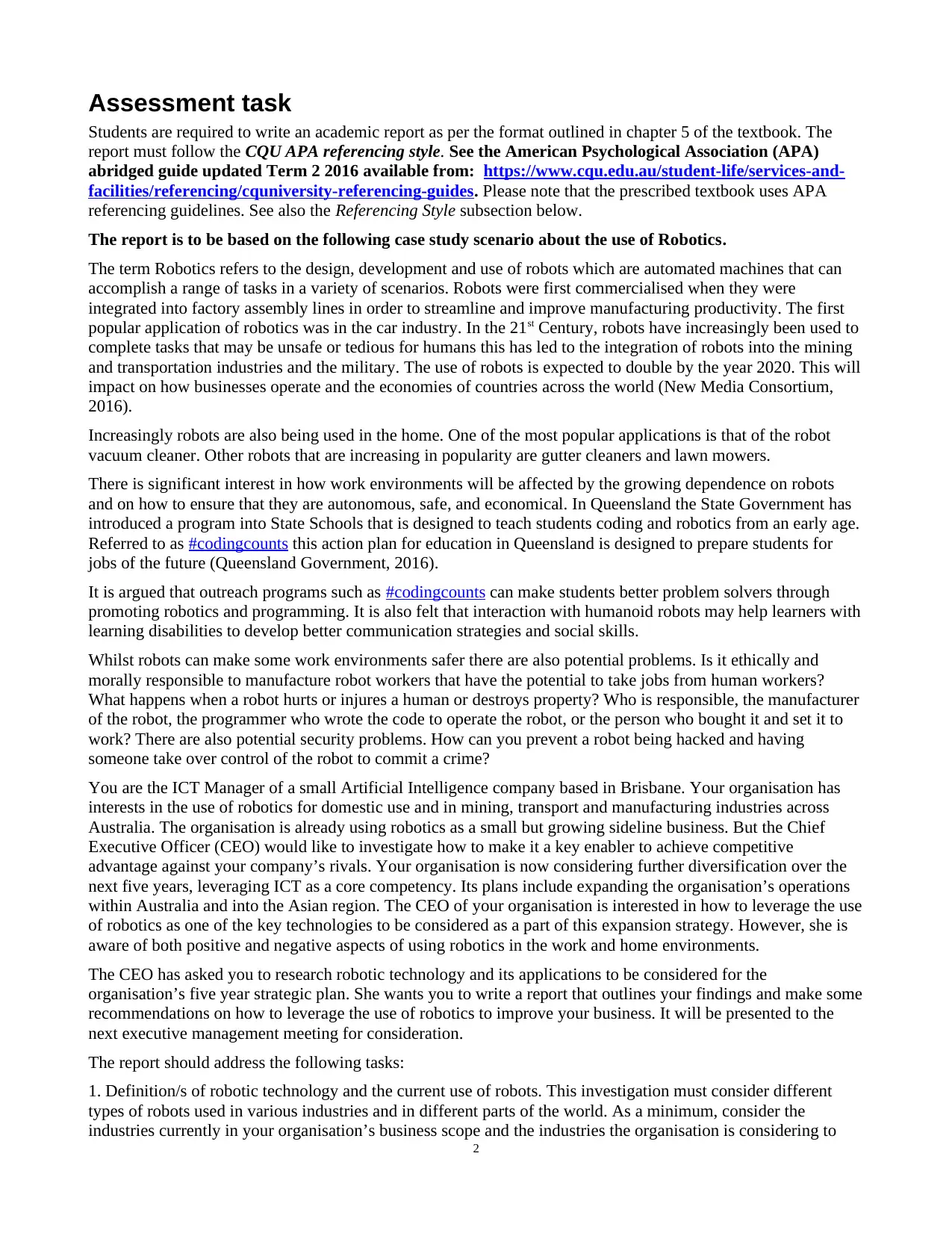
Assessment task
Students are required to write an academic report as per the format outlined in chapter 5 of the textbook. The
report must follow the CQU APA referencing style. See the American Psychological Association (APA)
abridged guide updated Term 2 2016 available from: https://www.cqu.edu.au/student-life/services-and-
facilities/referencing/cquniversity-referencing-guides. Please note that the prescribed textbook uses APA
referencing guidelines. See also the Referencing Style subsection below.
The report is to be based on the following case study scenario about the use of Robotics.
The term Robotics refers to the design, development and use of robots which are automated machines that can
accomplish a range of tasks in a variety of scenarios. Robots were first commercialised when they were
integrated into factory assembly lines in order to streamline and improve manufacturing productivity. The first
popular application of robotics was in the car industry. In the 21st Century, robots have increasingly been used to
complete tasks that may be unsafe or tedious for humans this has led to the integration of robots into the mining
and transportation industries and the military. The use of robots is expected to double by the year 2020. This will
impact on how businesses operate and the economies of countries across the world (New Media Consortium,
2016).
Increasingly robots are also being used in the home. One of the most popular applications is that of the robot
vacuum cleaner. Other robots that are increasing in popularity are gutter cleaners and lawn mowers.
There is significant interest in how work environments will be affected by the growing dependence on robots
and on how to ensure that they are autonomous, safe, and economical. In Queensland the State Government has
introduced a program into State Schools that is designed to teach students coding and robotics from an early age.
Referred to as #codingcounts this action plan for education in Queensland is designed to prepare students for
jobs of the future (Queensland Government, 2016).
It is argued that outreach programs such as #codingcounts can make students better problem solvers through
promoting robotics and programming. It is also felt that interaction with humanoid robots may help learners with
learning disabilities to develop better communication strategies and social skills.
Whilst robots can make some work environments safer there are also potential problems. Is it ethically and
morally responsible to manufacture robot workers that have the potential to take jobs from human workers?
What happens when a robot hurts or injures a human or destroys property? Who is responsible, the manufacturer
of the robot, the programmer who wrote the code to operate the robot, or the person who bought it and set it to
work? There are also potential security problems. How can you prevent a robot being hacked and having
someone take over control of the robot to commit a crime?
You are the ICT Manager of a small Artificial Intelligence company based in Brisbane. Your organisation has
interests in the use of robotics for domestic use and in mining, transport and manufacturing industries across
Australia. The organisation is already using robotics as a small but growing sideline business. But the Chief
Executive Officer (CEO) would like to investigate how to make it a key enabler to achieve competitive
advantage against your company’s rivals. Your organisation is now considering further diversification over the
next five years, leveraging ICT as a core competency. Its plans include expanding the organisation’s operations
within Australia and into the Asian region. The CEO of your organisation is interested in how to leverage the use
of robotics as one of the key technologies to be considered as a part of this expansion strategy. However, she is
aware of both positive and negative aspects of using robotics in the work and home environments.
The CEO has asked you to research robotic technology and its applications to be considered for the
organisation’s five year strategic plan. She wants you to write a report that outlines your findings and make some
recommendations on how to leverage the use of robotics to improve your business. It will be presented to the
next executive management meeting for consideration.
The report should address the following tasks:
1. Definition/s of robotic technology and the current use of robots. This investigation must consider different
types of robots used in various industries and in different parts of the world. As a minimum, consider the
industries currently in your organisation’s business scope and the industries the organisation is considering to
2
Students are required to write an academic report as per the format outlined in chapter 5 of the textbook. The
report must follow the CQU APA referencing style. See the American Psychological Association (APA)
abridged guide updated Term 2 2016 available from: https://www.cqu.edu.au/student-life/services-and-
facilities/referencing/cquniversity-referencing-guides. Please note that the prescribed textbook uses APA
referencing guidelines. See also the Referencing Style subsection below.
The report is to be based on the following case study scenario about the use of Robotics.
The term Robotics refers to the design, development and use of robots which are automated machines that can
accomplish a range of tasks in a variety of scenarios. Robots were first commercialised when they were
integrated into factory assembly lines in order to streamline and improve manufacturing productivity. The first
popular application of robotics was in the car industry. In the 21st Century, robots have increasingly been used to
complete tasks that may be unsafe or tedious for humans this has led to the integration of robots into the mining
and transportation industries and the military. The use of robots is expected to double by the year 2020. This will
impact on how businesses operate and the economies of countries across the world (New Media Consortium,
2016).
Increasingly robots are also being used in the home. One of the most popular applications is that of the robot
vacuum cleaner. Other robots that are increasing in popularity are gutter cleaners and lawn mowers.
There is significant interest in how work environments will be affected by the growing dependence on robots
and on how to ensure that they are autonomous, safe, and economical. In Queensland the State Government has
introduced a program into State Schools that is designed to teach students coding and robotics from an early age.
Referred to as #codingcounts this action plan for education in Queensland is designed to prepare students for
jobs of the future (Queensland Government, 2016).
It is argued that outreach programs such as #codingcounts can make students better problem solvers through
promoting robotics and programming. It is also felt that interaction with humanoid robots may help learners with
learning disabilities to develop better communication strategies and social skills.
Whilst robots can make some work environments safer there are also potential problems. Is it ethically and
morally responsible to manufacture robot workers that have the potential to take jobs from human workers?
What happens when a robot hurts or injures a human or destroys property? Who is responsible, the manufacturer
of the robot, the programmer who wrote the code to operate the robot, or the person who bought it and set it to
work? There are also potential security problems. How can you prevent a robot being hacked and having
someone take over control of the robot to commit a crime?
You are the ICT Manager of a small Artificial Intelligence company based in Brisbane. Your organisation has
interests in the use of robotics for domestic use and in mining, transport and manufacturing industries across
Australia. The organisation is already using robotics as a small but growing sideline business. But the Chief
Executive Officer (CEO) would like to investigate how to make it a key enabler to achieve competitive
advantage against your company’s rivals. Your organisation is now considering further diversification over the
next five years, leveraging ICT as a core competency. Its plans include expanding the organisation’s operations
within Australia and into the Asian region. The CEO of your organisation is interested in how to leverage the use
of robotics as one of the key technologies to be considered as a part of this expansion strategy. However, she is
aware of both positive and negative aspects of using robotics in the work and home environments.
The CEO has asked you to research robotic technology and its applications to be considered for the
organisation’s five year strategic plan. She wants you to write a report that outlines your findings and make some
recommendations on how to leverage the use of robotics to improve your business. It will be presented to the
next executive management meeting for consideration.
The report should address the following tasks:
1. Definition/s of robotic technology and the current use of robots. This investigation must consider different
types of robots used in various industries and in different parts of the world. As a minimum, consider the
industries currently in your organisation’s business scope and the industries the organisation is considering to
2
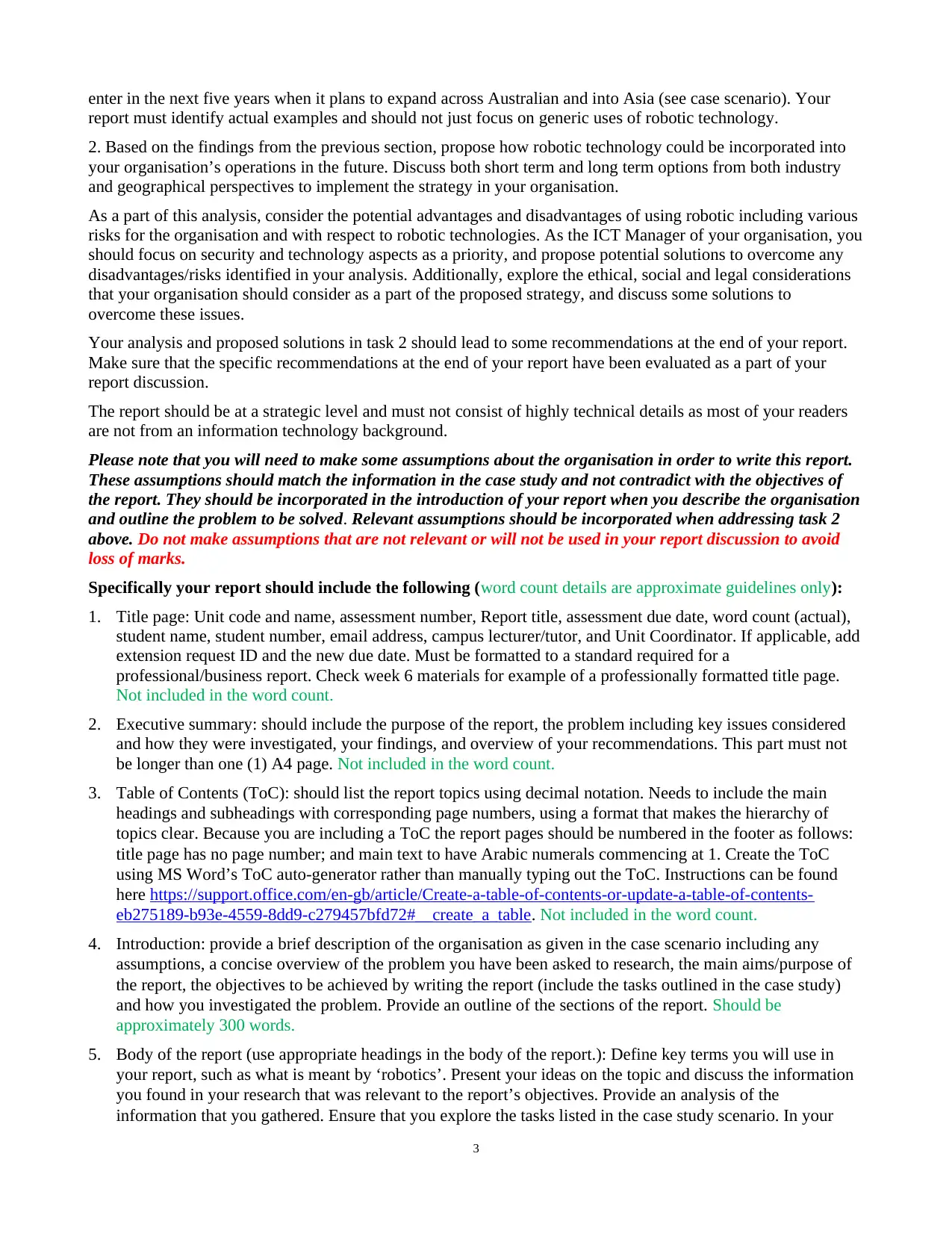
enter in the next five years when it plans to expand across Australian and into Asia (see case scenario). Your
report must identify actual examples and should not just focus on generic uses of robotic technology.
2. Based on the findings from the previous section, propose how robotic technology could be incorporated into
your organisation’s operations in the future. Discuss both short term and long term options from both industry
and geographical perspectives to implement the strategy in your organisation.
As a part of this analysis, consider the potential advantages and disadvantages of using robotic including various
risks for the organisation and with respect to robotic technologies. As the ICT Manager of your organisation, you
should focus on security and technology aspects as a priority, and propose potential solutions to overcome any
disadvantages/risks identified in your analysis. Additionally, explore the ethical, social and legal considerations
that your organisation should consider as a part of the proposed strategy, and discuss some solutions to
overcome these issues.
Your analysis and proposed solutions in task 2 should lead to some recommendations at the end of your report.
Make sure that the specific recommendations at the end of your report have been evaluated as a part of your
report discussion.
The report should be at a strategic level and must not consist of highly technical details as most of your readers
are not from an information technology background.
Please note that you will need to make some assumptions about the organisation in order to write this report.
These assumptions should match the information in the case study and not contradict with the objectives of
the report. They should be incorporated in the introduction of your report when you describe the organisation
and outline the problem to be solved. Relevant assumptions should be incorporated when addressing task 2
above. Do not make assumptions that are not relevant or will not be used in your report discussion to avoid
loss of marks.
Specifically your report should include the following (word count details are approximate guidelines only):
1. Title page: Unit code and name, assessment number, Report title, assessment due date, word count (actual),
student name, student number, email address, campus lecturer/tutor, and Unit Coordinator. If applicable, add
extension request ID and the new due date. Must be formatted to a standard required for a
professional/business report. Check week 6 materials for example of a professionally formatted title page.
Not included in the word count.
2. Executive summary: should include the purpose of the report, the problem including key issues considered
and how they were investigated, your findings, and overview of your recommendations. This part must not
be longer than one (1) A4 page. Not included in the word count.
3. Table of Contents (ToC): should list the report topics using decimal notation. Needs to include the main
headings and subheadings with corresponding page numbers, using a format that makes the hierarchy of
topics clear. Because you are including a ToC the report pages should be numbered in the footer as follows:
title page has no page number; and main text to have Arabic numerals commencing at 1. Create the ToC
using MS Word’s ToC auto-generator rather than manually typing out the ToC. Instructions can be found
here https://support.office.com/en-gb/article/Create-a-table-of-contents-or-update-a-table-of-contents-
eb275189-b93e-4559-8dd9-c279457bfd72#__create_a_table. Not included in the word count.
4. Introduction: provide a brief description of the organisation as given in the case scenario including any
assumptions, a concise overview of the problem you have been asked to research, the main aims/purpose of
the report, the objectives to be achieved by writing the report (include the tasks outlined in the case study)
and how you investigated the problem. Provide an outline of the sections of the report. Should be
approximately 300 words.
5. Body of the report (use appropriate headings in the body of the report.): Define key terms you will use in
your report, such as what is meant by ‘robotics’. Present your ideas on the topic and discuss the information
you found in your research that was relevant to the report’s objectives. Provide an analysis of the
information that you gathered. Ensure that you explore the tasks listed in the case study scenario. In your
3
report must identify actual examples and should not just focus on generic uses of robotic technology.
2. Based on the findings from the previous section, propose how robotic technology could be incorporated into
your organisation’s operations in the future. Discuss both short term and long term options from both industry
and geographical perspectives to implement the strategy in your organisation.
As a part of this analysis, consider the potential advantages and disadvantages of using robotic including various
risks for the organisation and with respect to robotic technologies. As the ICT Manager of your organisation, you
should focus on security and technology aspects as a priority, and propose potential solutions to overcome any
disadvantages/risks identified in your analysis. Additionally, explore the ethical, social and legal considerations
that your organisation should consider as a part of the proposed strategy, and discuss some solutions to
overcome these issues.
Your analysis and proposed solutions in task 2 should lead to some recommendations at the end of your report.
Make sure that the specific recommendations at the end of your report have been evaluated as a part of your
report discussion.
The report should be at a strategic level and must not consist of highly technical details as most of your readers
are not from an information technology background.
Please note that you will need to make some assumptions about the organisation in order to write this report.
These assumptions should match the information in the case study and not contradict with the objectives of
the report. They should be incorporated in the introduction of your report when you describe the organisation
and outline the problem to be solved. Relevant assumptions should be incorporated when addressing task 2
above. Do not make assumptions that are not relevant or will not be used in your report discussion to avoid
loss of marks.
Specifically your report should include the following (word count details are approximate guidelines only):
1. Title page: Unit code and name, assessment number, Report title, assessment due date, word count (actual),
student name, student number, email address, campus lecturer/tutor, and Unit Coordinator. If applicable, add
extension request ID and the new due date. Must be formatted to a standard required for a
professional/business report. Check week 6 materials for example of a professionally formatted title page.
Not included in the word count.
2. Executive summary: should include the purpose of the report, the problem including key issues considered
and how they were investigated, your findings, and overview of your recommendations. This part must not
be longer than one (1) A4 page. Not included in the word count.
3. Table of Contents (ToC): should list the report topics using decimal notation. Needs to include the main
headings and subheadings with corresponding page numbers, using a format that makes the hierarchy of
topics clear. Because you are including a ToC the report pages should be numbered in the footer as follows:
title page has no page number; and main text to have Arabic numerals commencing at 1. Create the ToC
using MS Word’s ToC auto-generator rather than manually typing out the ToC. Instructions can be found
here https://support.office.com/en-gb/article/Create-a-table-of-contents-or-update-a-table-of-contents-
eb275189-b93e-4559-8dd9-c279457bfd72#__create_a_table. Not included in the word count.
4. Introduction: provide a brief description of the organisation as given in the case scenario including any
assumptions, a concise overview of the problem you have been asked to research, the main aims/purpose of
the report, the objectives to be achieved by writing the report (include the tasks outlined in the case study)
and how you investigated the problem. Provide an outline of the sections of the report. Should be
approximately 300 words.
5. Body of the report (use appropriate headings in the body of the report.): Define key terms you will use in
your report, such as what is meant by ‘robotics’. Present your ideas on the topic and discuss the information
you found in your research that was relevant to the report’s objectives. Provide an analysis of the
information that you gathered. Ensure that you explore the tasks listed in the case study scenario. In your
3
⊘ This is a preview!⊘
Do you want full access?
Subscribe today to unlock all pages.

Trusted by 1+ million students worldwide
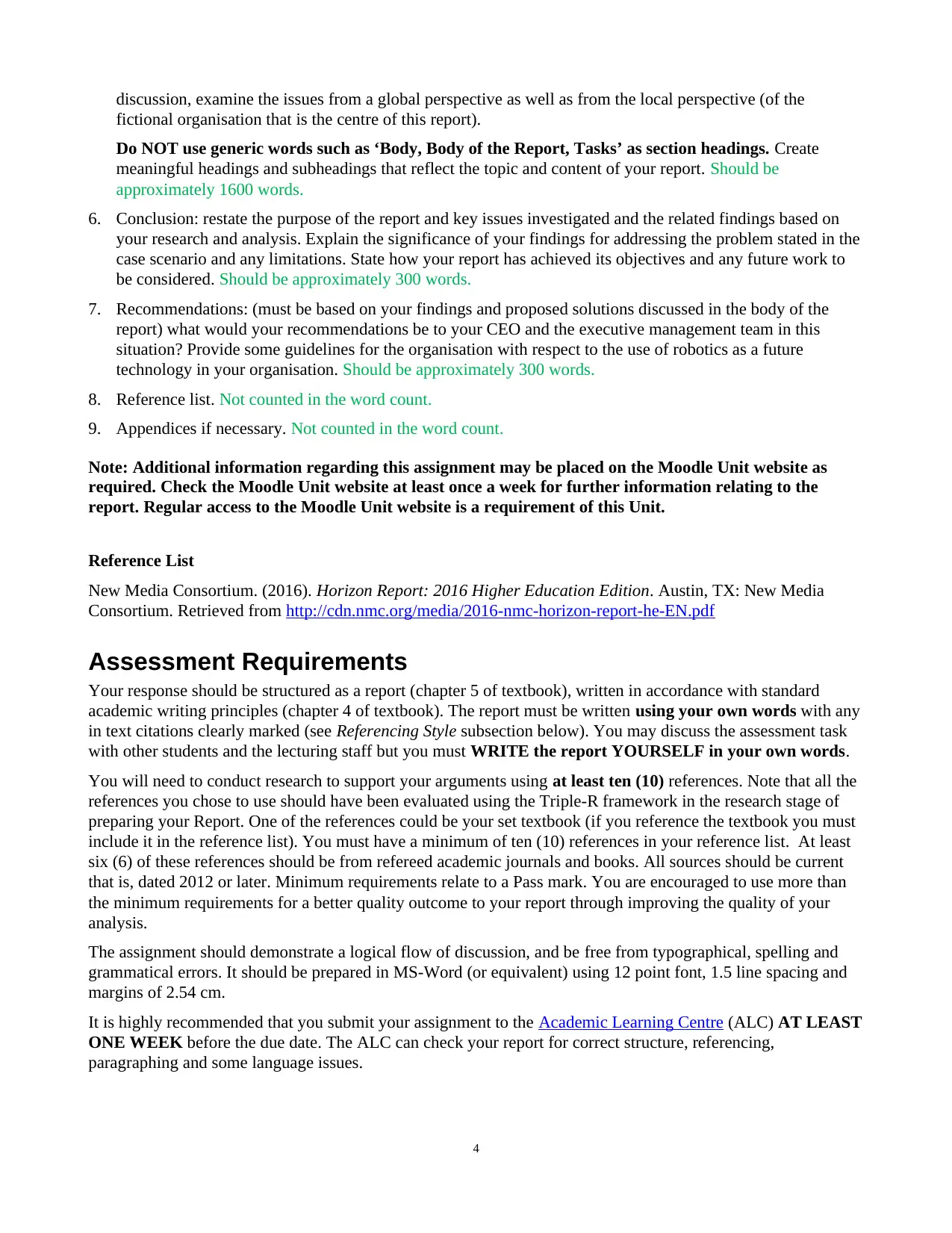
discussion, examine the issues from a global perspective as well as from the local perspective (of the
fictional organisation that is the centre of this report).
Do NOT use generic words such as ‘Body, Body of the Report, Tasks’ as section headings. Create
meaningful headings and subheadings that reflect the topic and content of your report. Should be
approximately 1600 words.
6. Conclusion: restate the purpose of the report and key issues investigated and the related findings based on
your research and analysis. Explain the significance of your findings for addressing the problem stated in the
case scenario and any limitations. State how your report has achieved its objectives and any future work to
be considered. Should be approximately 300 words.
7. Recommendations: (must be based on your findings and proposed solutions discussed in the body of the
report) what would your recommendations be to your CEO and the executive management team in this
situation? Provide some guidelines for the organisation with respect to the use of robotics as a future
technology in your organisation. Should be approximately 300 words.
8. Reference list. Not counted in the word count.
9. Appendices if necessary. Not counted in the word count.
Note: Additional information regarding this assignment may be placed on the Moodle Unit website as
required. Check the Moodle Unit website at least once a week for further information relating to the
report. Regular access to the Moodle Unit website is a requirement of this Unit.
Reference List
New Media Consortium. (2016). Horizon Report: 2016 Higher Education Edition. Austin, TX: New Media
Consortium. Retrieved from http://cdn.nmc.org/media/2016-nmc-horizon-report-he-EN.pdf
Assessment Requirements
Your response should be structured as a report (chapter 5 of textbook), written in accordance with standard
academic writing principles (chapter 4 of textbook). The report must be written using your own words with any
in text citations clearly marked (see Referencing Style subsection below). You may discuss the assessment task
with other students and the lecturing staff but you must WRITE the report YOURSELF in your own words.
You will need to conduct research to support your arguments using at least ten (10) references. Note that all the
references you chose to use should have been evaluated using the Triple-R framework in the research stage of
preparing your Report. One of the references could be your set textbook (if you reference the textbook you must
include it in the reference list). You must have a minimum of ten (10) references in your reference list. At least
six (6) of these references should be from refereed academic journals and books. All sources should be current
that is, dated 2012 or later. Minimum requirements relate to a Pass mark. You are encouraged to use more than
the minimum requirements for a better quality outcome to your report through improving the quality of your
analysis.
The assignment should demonstrate a logical flow of discussion, and be free from typographical, spelling and
grammatical errors. It should be prepared in MS-Word (or equivalent) using 12 point font, 1.5 line spacing and
margins of 2.54 cm.
It is highly recommended that you submit your assignment to the Academic Learning Centre (ALC) AT LEAST
ONE WEEK before the due date. The ALC can check your report for correct structure, referencing,
paragraphing and some language issues.
4
fictional organisation that is the centre of this report).
Do NOT use generic words such as ‘Body, Body of the Report, Tasks’ as section headings. Create
meaningful headings and subheadings that reflect the topic and content of your report. Should be
approximately 1600 words.
6. Conclusion: restate the purpose of the report and key issues investigated and the related findings based on
your research and analysis. Explain the significance of your findings for addressing the problem stated in the
case scenario and any limitations. State how your report has achieved its objectives and any future work to
be considered. Should be approximately 300 words.
7. Recommendations: (must be based on your findings and proposed solutions discussed in the body of the
report) what would your recommendations be to your CEO and the executive management team in this
situation? Provide some guidelines for the organisation with respect to the use of robotics as a future
technology in your organisation. Should be approximately 300 words.
8. Reference list. Not counted in the word count.
9. Appendices if necessary. Not counted in the word count.
Note: Additional information regarding this assignment may be placed on the Moodle Unit website as
required. Check the Moodle Unit website at least once a week for further information relating to the
report. Regular access to the Moodle Unit website is a requirement of this Unit.
Reference List
New Media Consortium. (2016). Horizon Report: 2016 Higher Education Edition. Austin, TX: New Media
Consortium. Retrieved from http://cdn.nmc.org/media/2016-nmc-horizon-report-he-EN.pdf
Assessment Requirements
Your response should be structured as a report (chapter 5 of textbook), written in accordance with standard
academic writing principles (chapter 4 of textbook). The report must be written using your own words with any
in text citations clearly marked (see Referencing Style subsection below). You may discuss the assessment task
with other students and the lecturing staff but you must WRITE the report YOURSELF in your own words.
You will need to conduct research to support your arguments using at least ten (10) references. Note that all the
references you chose to use should have been evaluated using the Triple-R framework in the research stage of
preparing your Report. One of the references could be your set textbook (if you reference the textbook you must
include it in the reference list). You must have a minimum of ten (10) references in your reference list. At least
six (6) of these references should be from refereed academic journals and books. All sources should be current
that is, dated 2012 or later. Minimum requirements relate to a Pass mark. You are encouraged to use more than
the minimum requirements for a better quality outcome to your report through improving the quality of your
analysis.
The assignment should demonstrate a logical flow of discussion, and be free from typographical, spelling and
grammatical errors. It should be prepared in MS-Word (or equivalent) using 12 point font, 1.5 line spacing and
margins of 2.54 cm.
It is highly recommended that you submit your assignment to the Academic Learning Centre (ALC) AT LEAST
ONE WEEK before the due date. The ALC can check your report for correct structure, referencing,
paragraphing and some language issues.
4
Paraphrase This Document
Need a fresh take? Get an instant paraphrase of this document with our AI Paraphraser
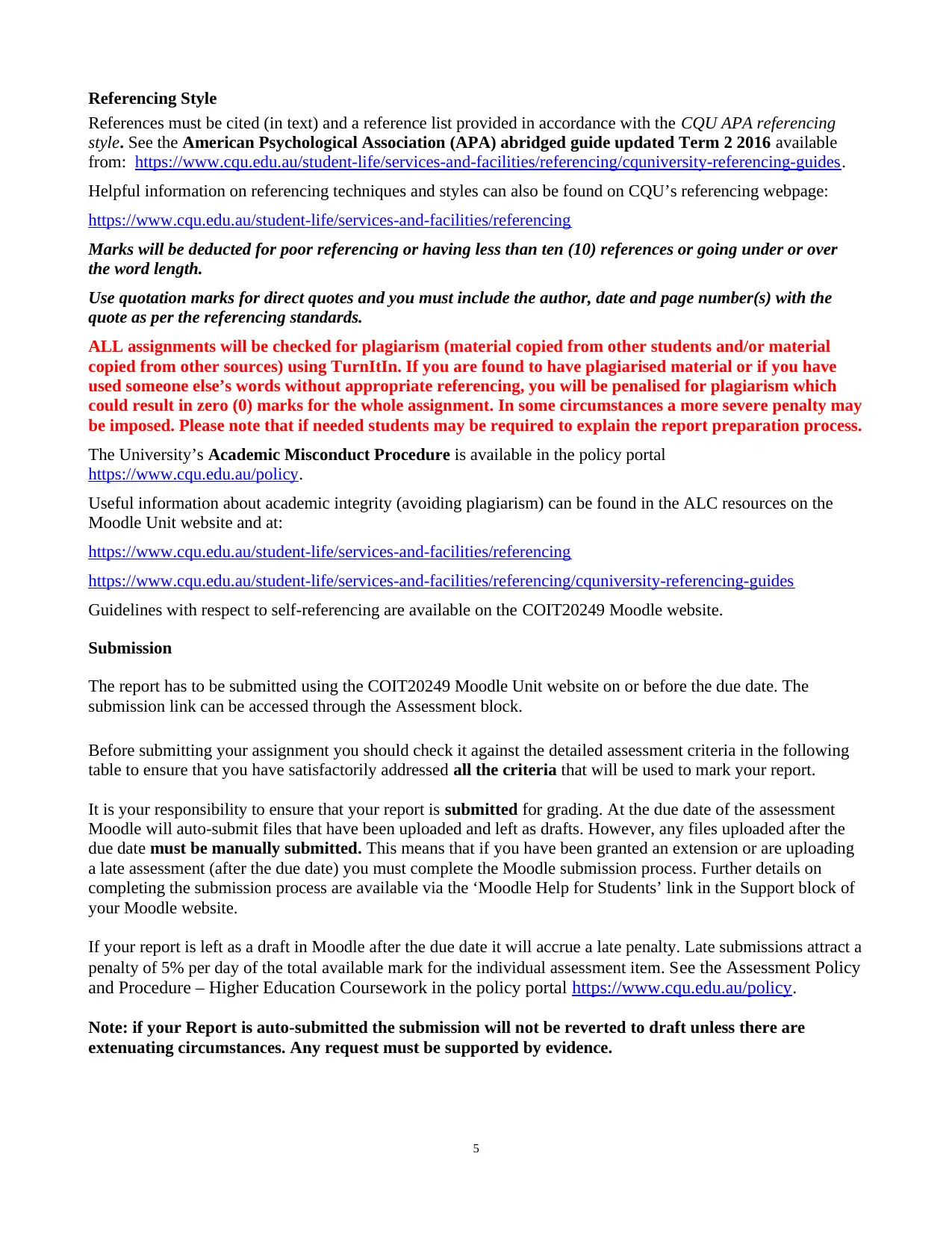
Referencing Style
References must be cited (in text) and a reference list provided in accordance with the CQU APA referencing
style. See the American Psychological Association (APA) abridged guide updated Term 2 2016 available
from: https://www.cqu.edu.au/student-life/services-and-facilities/referencing/cquniversity-referencing-guides.
Helpful information on referencing techniques and styles can also be found on CQU’s referencing webpage:
https://www.cqu.edu.au/student-life/services-and-facilities/referencing
Marks will be deducted for poor referencing or having less than ten (10) references or going under or over
the word length.
Use quotation marks for direct quotes and you must include the author, date and page number(s) with the
quote as per the referencing standards.
ALL assignments will be checked for plagiarism (material copied from other students and/or material
copied from other sources) using TurnItIn. If you are found to have plagiarised material or if you have
used someone else’s words without appropriate referencing, you will be penalised for plagiarism which
could result in zero (0) marks for the whole assignment. In some circumstances a more severe penalty may
be imposed. Please note that if needed students may be required to explain the report preparation process.
The University’s Academic Misconduct Procedure is available in the policy portal
https://www.cqu.edu.au/policy.
Useful information about academic integrity (avoiding plagiarism) can be found in the ALC resources on the
Moodle Unit website and at:
https://www.cqu.edu.au/student-life/services-and-facilities/referencing
https://www.cqu.edu.au/student-life/services-and-facilities/referencing/cquniversity-referencing-guides
Guidelines with respect to self-referencing are available on the COIT20249 Moodle website.
Submission
The report has to be submitted using the COIT20249 Moodle Unit website on or before the due date. The
submission link can be accessed through the Assessment block.
Before submitting your assignment you should check it against the detailed assessment criteria in the following
table to ensure that you have satisfactorily addressed all the criteria that will be used to mark your report.
It is your responsibility to ensure that your report is submitted for grading. At the due date of the assessment
Moodle will auto-submit files that have been uploaded and left as drafts. However, any files uploaded after the
due date must be manually submitted. This means that if you have been granted an extension or are uploading
a late assessment (after the due date) you must complete the Moodle submission process. Further details on
completing the submission process are available via the ‘Moodle Help for Students’ link in the Support block of
your Moodle website.
If your report is left as a draft in Moodle after the due date it will accrue a late penalty. Late submissions attract a
penalty of 5% per day of the total available mark for the individual assessment item. See the Assessment Policy
and Procedure – Higher Education Coursework in the policy portal https://www.cqu.edu.au/policy.
Note: if your Report is auto-submitted the submission will not be reverted to draft unless there are
extenuating circumstances. Any request must be supported by evidence.
5
References must be cited (in text) and a reference list provided in accordance with the CQU APA referencing
style. See the American Psychological Association (APA) abridged guide updated Term 2 2016 available
from: https://www.cqu.edu.au/student-life/services-and-facilities/referencing/cquniversity-referencing-guides.
Helpful information on referencing techniques and styles can also be found on CQU’s referencing webpage:
https://www.cqu.edu.au/student-life/services-and-facilities/referencing
Marks will be deducted for poor referencing or having less than ten (10) references or going under or over
the word length.
Use quotation marks for direct quotes and you must include the author, date and page number(s) with the
quote as per the referencing standards.
ALL assignments will be checked for plagiarism (material copied from other students and/or material
copied from other sources) using TurnItIn. If you are found to have plagiarised material or if you have
used someone else’s words without appropriate referencing, you will be penalised for plagiarism which
could result in zero (0) marks for the whole assignment. In some circumstances a more severe penalty may
be imposed. Please note that if needed students may be required to explain the report preparation process.
The University’s Academic Misconduct Procedure is available in the policy portal
https://www.cqu.edu.au/policy.
Useful information about academic integrity (avoiding plagiarism) can be found in the ALC resources on the
Moodle Unit website and at:
https://www.cqu.edu.au/student-life/services-and-facilities/referencing
https://www.cqu.edu.au/student-life/services-and-facilities/referencing/cquniversity-referencing-guides
Guidelines with respect to self-referencing are available on the COIT20249 Moodle website.
Submission
The report has to be submitted using the COIT20249 Moodle Unit website on or before the due date. The
submission link can be accessed through the Assessment block.
Before submitting your assignment you should check it against the detailed assessment criteria in the following
table to ensure that you have satisfactorily addressed all the criteria that will be used to mark your report.
It is your responsibility to ensure that your report is submitted for grading. At the due date of the assessment
Moodle will auto-submit files that have been uploaded and left as drafts. However, any files uploaded after the
due date must be manually submitted. This means that if you have been granted an extension or are uploading
a late assessment (after the due date) you must complete the Moodle submission process. Further details on
completing the submission process are available via the ‘Moodle Help for Students’ link in the Support block of
your Moodle website.
If your report is left as a draft in Moodle after the due date it will accrue a late penalty. Late submissions attract a
penalty of 5% per day of the total available mark for the individual assessment item. See the Assessment Policy
and Procedure – Higher Education Coursework in the policy portal https://www.cqu.edu.au/policy.
Note: if your Report is auto-submitted the submission will not be reverted to draft unless there are
extenuating circumstances. Any request must be supported by evidence.
5
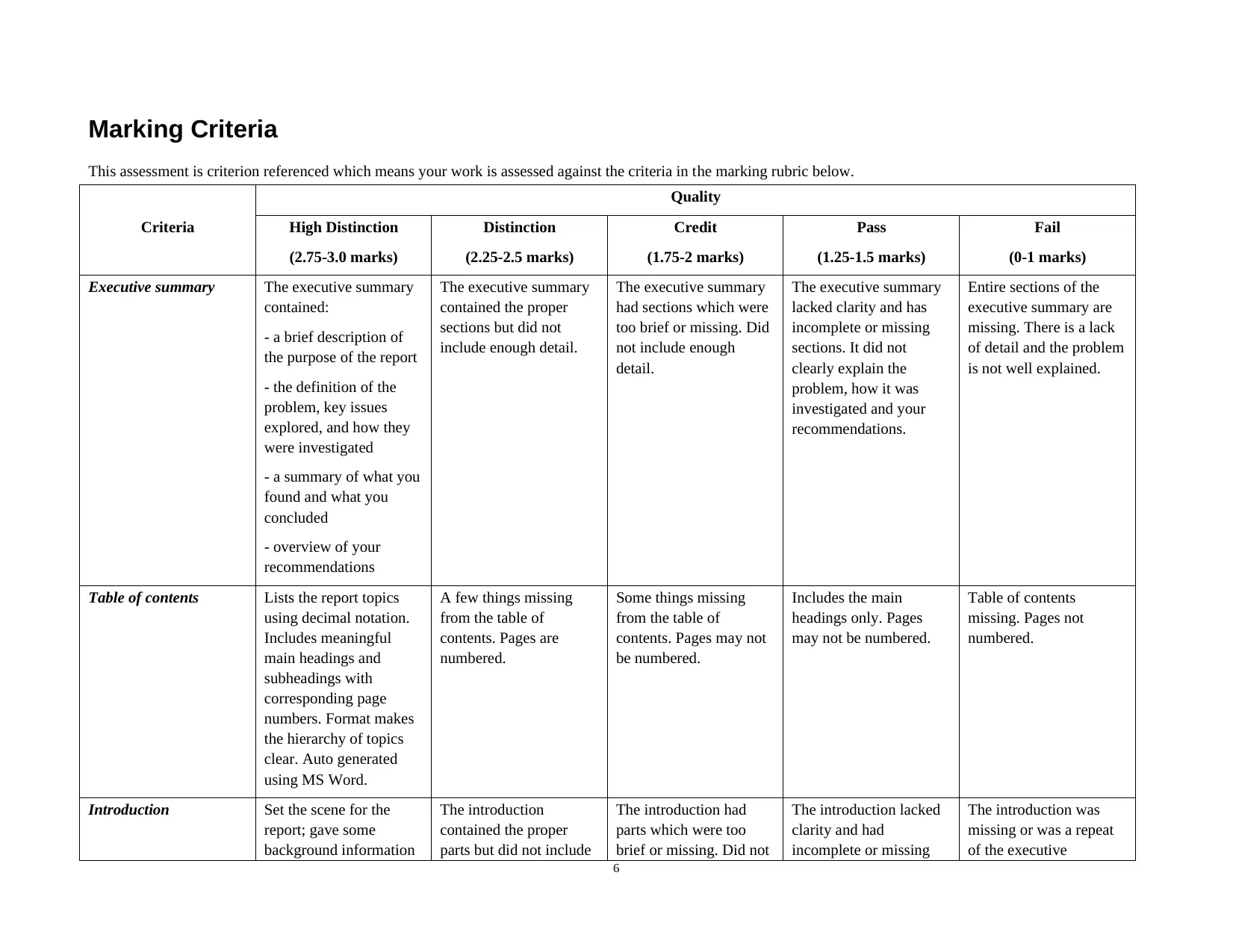
Marking Criteria
This assessment is criterion referenced which means your work is assessed against the criteria in the marking rubric below.
Criteria
Quality
High Distinction
(2.75-3.0 marks)
Distinction
(2.25-2.5 marks)
Credit
(1.75-2 marks)
Pass
(1.25-1.5 marks)
Fail
(0-1 marks)
Executive summary The executive summary
contained:
- a brief description of
the purpose of the report
- the definition of the
problem, key issues
explored, and how they
were investigated
- a summary of what you
found and what you
concluded
- overview of your
recommendations
The executive summary
contained the proper
sections but did not
include enough detail.
The executive summary
had sections which were
too brief or missing. Did
not include enough
detail.
The executive summary
lacked clarity and has
incomplete or missing
sections. It did not
clearly explain the
problem, how it was
investigated and your
recommendations.
Entire sections of the
executive summary are
missing. There is a lack
of detail and the problem
is not well explained.
Table of contents Lists the report topics
using decimal notation.
Includes meaningful
main headings and
subheadings with
corresponding page
numbers. Format makes
the hierarchy of topics
clear. Auto generated
using MS Word.
A few things missing
from the table of
contents. Pages are
numbered.
Some things missing
from the table of
contents. Pages may not
be numbered.
Includes the main
headings only. Pages
may not be numbered.
Table of contents
missing. Pages not
numbered.
Introduction Set the scene for the
report; gave some
background information
The introduction
contained the proper
parts but did not include
The introduction had
parts which were too
brief or missing. Did not
The introduction lacked
clarity and had
incomplete or missing
The introduction was
missing or was a repeat
of the executive
6
This assessment is criterion referenced which means your work is assessed against the criteria in the marking rubric below.
Criteria
Quality
High Distinction
(2.75-3.0 marks)
Distinction
(2.25-2.5 marks)
Credit
(1.75-2 marks)
Pass
(1.25-1.5 marks)
Fail
(0-1 marks)
Executive summary The executive summary
contained:
- a brief description of
the purpose of the report
- the definition of the
problem, key issues
explored, and how they
were investigated
- a summary of what you
found and what you
concluded
- overview of your
recommendations
The executive summary
contained the proper
sections but did not
include enough detail.
The executive summary
had sections which were
too brief or missing. Did
not include enough
detail.
The executive summary
lacked clarity and has
incomplete or missing
sections. It did not
clearly explain the
problem, how it was
investigated and your
recommendations.
Entire sections of the
executive summary are
missing. There is a lack
of detail and the problem
is not well explained.
Table of contents Lists the report topics
using decimal notation.
Includes meaningful
main headings and
subheadings with
corresponding page
numbers. Format makes
the hierarchy of topics
clear. Auto generated
using MS Word.
A few things missing
from the table of
contents. Pages are
numbered.
Some things missing
from the table of
contents. Pages may not
be numbered.
Includes the main
headings only. Pages
may not be numbered.
Table of contents
missing. Pages not
numbered.
Introduction Set the scene for the
report; gave some
background information
The introduction
contained the proper
parts but did not include
The introduction had
parts which were too
brief or missing. Did not
The introduction lacked
clarity and had
incomplete or missing
The introduction was
missing or was a repeat
of the executive
6
⊘ This is a preview!⊘
Do you want full access?
Subscribe today to unlock all pages.

Trusted by 1+ million students worldwide
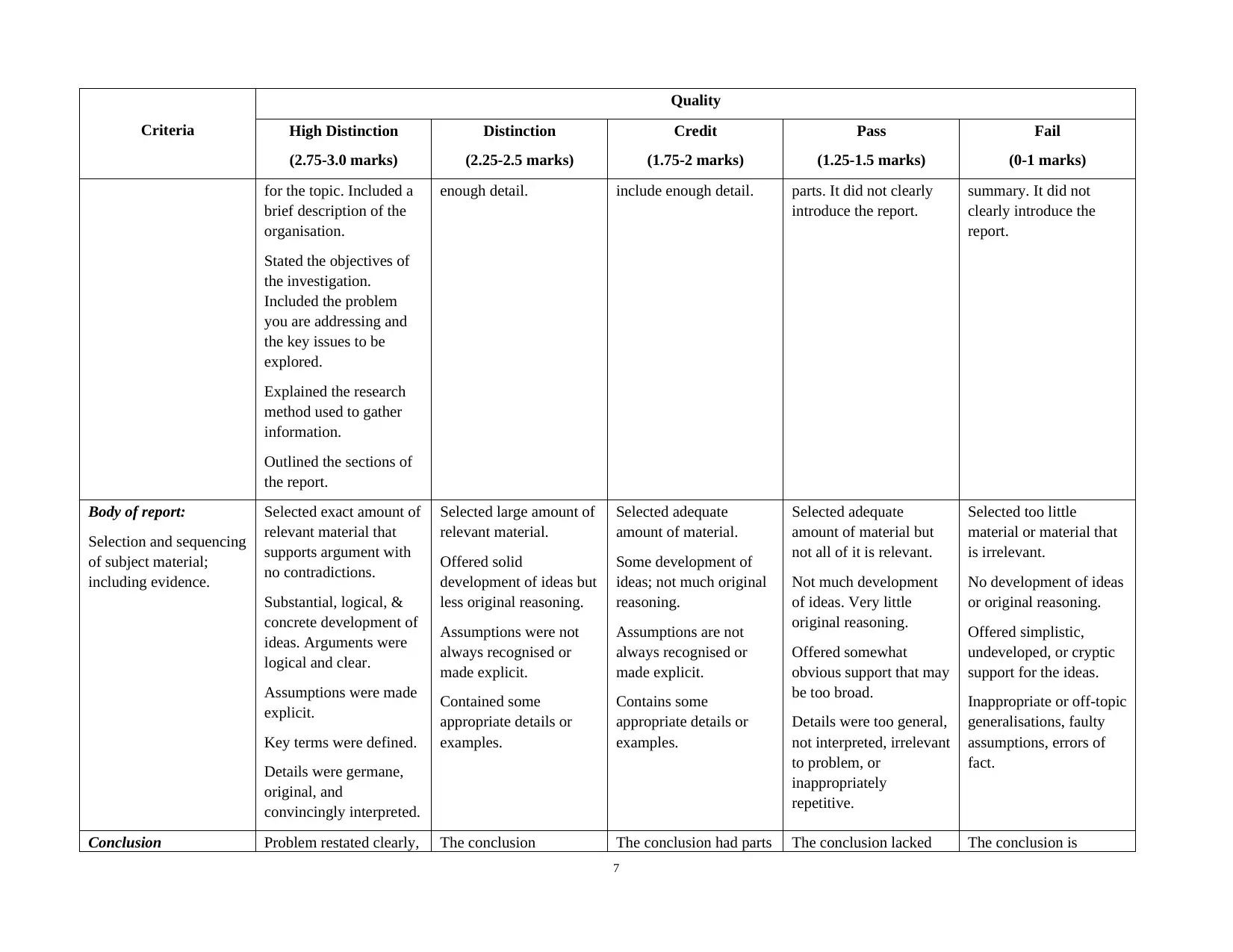
Criteria
Quality
High Distinction
(2.75-3.0 marks)
Distinction
(2.25-2.5 marks)
Credit
(1.75-2 marks)
Pass
(1.25-1.5 marks)
Fail
(0-1 marks)
for the topic. Included a
brief description of the
organisation.
Stated the objectives of
the investigation.
Included the problem
you are addressing and
the key issues to be
explored.
Explained the research
method used to gather
information.
Outlined the sections of
the report.
enough detail. include enough detail. parts. It did not clearly
introduce the report.
summary. It did not
clearly introduce the
report.
Body of report:
Selection and sequencing
of subject material;
including evidence.
Selected exact amount of
relevant material that
supports argument with
no contradictions.
Substantial, logical, &
concrete development of
ideas. Arguments were
logical and clear.
Assumptions were made
explicit.
Key terms were defined.
Details were germane,
original, and
convincingly interpreted.
Selected large amount of
relevant material.
Offered solid
development of ideas but
less original reasoning.
Assumptions were not
always recognised or
made explicit.
Contained some
appropriate details or
examples.
Selected adequate
amount of material.
Some development of
ideas; not much original
reasoning.
Assumptions are not
always recognised or
made explicit.
Contains some
appropriate details or
examples.
Selected adequate
amount of material but
not all of it is relevant.
Not much development
of ideas. Very little
original reasoning.
Offered somewhat
obvious support that may
be too broad.
Details were too general,
not interpreted, irrelevant
to problem, or
inappropriately
repetitive.
Selected too little
material or material that
is irrelevant.
No development of ideas
or original reasoning.
Offered simplistic,
undeveloped, or cryptic
support for the ideas.
Inappropriate or off-topic
generalisations, faulty
assumptions, errors of
fact.
Conclusion Problem restated clearly, The conclusion The conclusion had parts The conclusion lacked The conclusion is
7
Quality
High Distinction
(2.75-3.0 marks)
Distinction
(2.25-2.5 marks)
Credit
(1.75-2 marks)
Pass
(1.25-1.5 marks)
Fail
(0-1 marks)
for the topic. Included a
brief description of the
organisation.
Stated the objectives of
the investigation.
Included the problem
you are addressing and
the key issues to be
explored.
Explained the research
method used to gather
information.
Outlined the sections of
the report.
enough detail. include enough detail. parts. It did not clearly
introduce the report.
summary. It did not
clearly introduce the
report.
Body of report:
Selection and sequencing
of subject material;
including evidence.
Selected exact amount of
relevant material that
supports argument with
no contradictions.
Substantial, logical, &
concrete development of
ideas. Arguments were
logical and clear.
Assumptions were made
explicit.
Key terms were defined.
Details were germane,
original, and
convincingly interpreted.
Selected large amount of
relevant material.
Offered solid
development of ideas but
less original reasoning.
Assumptions were not
always recognised or
made explicit.
Contained some
appropriate details or
examples.
Selected adequate
amount of material.
Some development of
ideas; not much original
reasoning.
Assumptions are not
always recognised or
made explicit.
Contains some
appropriate details or
examples.
Selected adequate
amount of material but
not all of it is relevant.
Not much development
of ideas. Very little
original reasoning.
Offered somewhat
obvious support that may
be too broad.
Details were too general,
not interpreted, irrelevant
to problem, or
inappropriately
repetitive.
Selected too little
material or material that
is irrelevant.
No development of ideas
or original reasoning.
Offered simplistic,
undeveloped, or cryptic
support for the ideas.
Inappropriate or off-topic
generalisations, faulty
assumptions, errors of
fact.
Conclusion Problem restated clearly, The conclusion The conclusion had parts The conclusion lacked The conclusion is
7
Paraphrase This Document
Need a fresh take? Get an instant paraphrase of this document with our AI Paraphraser
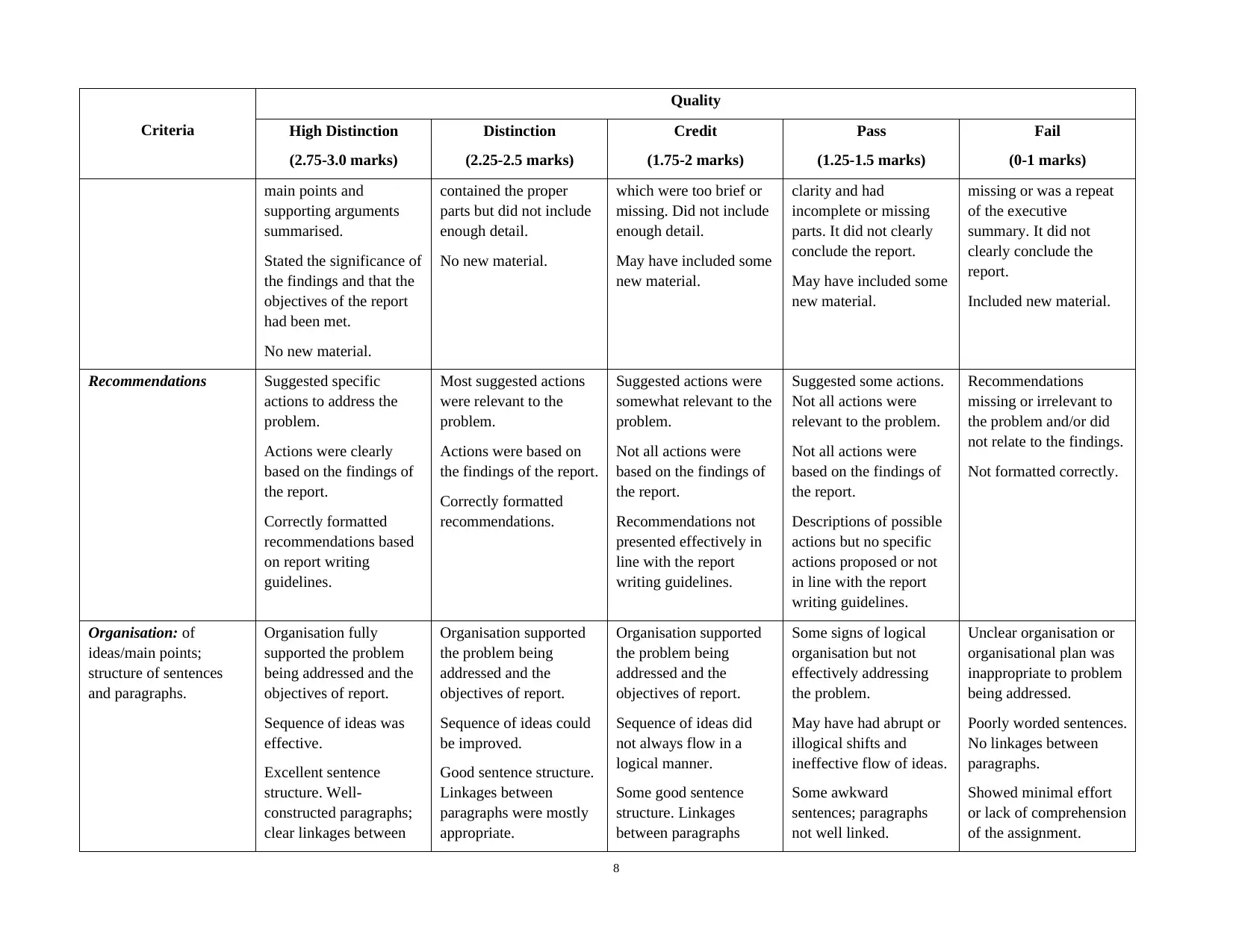
Criteria
Quality
High Distinction
(2.75-3.0 marks)
Distinction
(2.25-2.5 marks)
Credit
(1.75-2 marks)
Pass
(1.25-1.5 marks)
Fail
(0-1 marks)
main points and
supporting arguments
summarised.
Stated the significance of
the findings and that the
objectives of the report
had been met.
No new material.
contained the proper
parts but did not include
enough detail.
No new material.
which were too brief or
missing. Did not include
enough detail.
May have included some
new material.
clarity and had
incomplete or missing
parts. It did not clearly
conclude the report.
May have included some
new material.
missing or was a repeat
of the executive
summary. It did not
clearly conclude the
report.
Included new material.
Recommendations Suggested specific
actions to address the
problem.
Actions were clearly
based on the findings of
the report.
Correctly formatted
recommendations based
on report writing
guidelines.
Most suggested actions
were relevant to the
problem.
Actions were based on
the findings of the report.
Correctly formatted
recommendations.
Suggested actions were
somewhat relevant to the
problem.
Not all actions were
based on the findings of
the report.
Recommendations not
presented effectively in
line with the report
writing guidelines.
Suggested some actions.
Not all actions were
relevant to the problem.
Not all actions were
based on the findings of
the report.
Descriptions of possible
actions but no specific
actions proposed or not
in line with the report
writing guidelines.
Recommendations
missing or irrelevant to
the problem and/or did
not relate to the findings.
Not formatted correctly.
Organisation: of
ideas/main points;
structure of sentences
and paragraphs.
Organisation fully
supported the problem
being addressed and the
objectives of report.
Sequence of ideas was
effective.
Excellent sentence
structure. Well-
constructed paragraphs;
clear linkages between
Organisation supported
the problem being
addressed and the
objectives of report.
Sequence of ideas could
be improved.
Good sentence structure.
Linkages between
paragraphs were mostly
appropriate.
Organisation supported
the problem being
addressed and the
objectives of report.
Sequence of ideas did
not always flow in a
logical manner.
Some good sentence
structure. Linkages
between paragraphs
Some signs of logical
organisation but not
effectively addressing
the problem.
May have had abrupt or
illogical shifts and
ineffective flow of ideas.
Some awkward
sentences; paragraphs
not well linked.
Unclear organisation or
organisational plan was
inappropriate to problem
being addressed.
Poorly worded sentences.
No linkages between
paragraphs.
Showed minimal effort
or lack of comprehension
of the assignment.
8
Quality
High Distinction
(2.75-3.0 marks)
Distinction
(2.25-2.5 marks)
Credit
(1.75-2 marks)
Pass
(1.25-1.5 marks)
Fail
(0-1 marks)
main points and
supporting arguments
summarised.
Stated the significance of
the findings and that the
objectives of the report
had been met.
No new material.
contained the proper
parts but did not include
enough detail.
No new material.
which were too brief or
missing. Did not include
enough detail.
May have included some
new material.
clarity and had
incomplete or missing
parts. It did not clearly
conclude the report.
May have included some
new material.
missing or was a repeat
of the executive
summary. It did not
clearly conclude the
report.
Included new material.
Recommendations Suggested specific
actions to address the
problem.
Actions were clearly
based on the findings of
the report.
Correctly formatted
recommendations based
on report writing
guidelines.
Most suggested actions
were relevant to the
problem.
Actions were based on
the findings of the report.
Correctly formatted
recommendations.
Suggested actions were
somewhat relevant to the
problem.
Not all actions were
based on the findings of
the report.
Recommendations not
presented effectively in
line with the report
writing guidelines.
Suggested some actions.
Not all actions were
relevant to the problem.
Not all actions were
based on the findings of
the report.
Descriptions of possible
actions but no specific
actions proposed or not
in line with the report
writing guidelines.
Recommendations
missing or irrelevant to
the problem and/or did
not relate to the findings.
Not formatted correctly.
Organisation: of
ideas/main points;
structure of sentences
and paragraphs.
Organisation fully
supported the problem
being addressed and the
objectives of report.
Sequence of ideas was
effective.
Excellent sentence
structure. Well-
constructed paragraphs;
clear linkages between
Organisation supported
the problem being
addressed and the
objectives of report.
Sequence of ideas could
be improved.
Good sentence structure.
Linkages between
paragraphs were mostly
appropriate.
Organisation supported
the problem being
addressed and the
objectives of report.
Sequence of ideas did
not always flow in a
logical manner.
Some good sentence
structure. Linkages
between paragraphs
Some signs of logical
organisation but not
effectively addressing
the problem.
May have had abrupt or
illogical shifts and
ineffective flow of ideas.
Some awkward
sentences; paragraphs
not well linked.
Unclear organisation or
organisational plan was
inappropriate to problem
being addressed.
Poorly worded sentences.
No linkages between
paragraphs.
Showed minimal effort
or lack of comprehension
of the assignment.
8
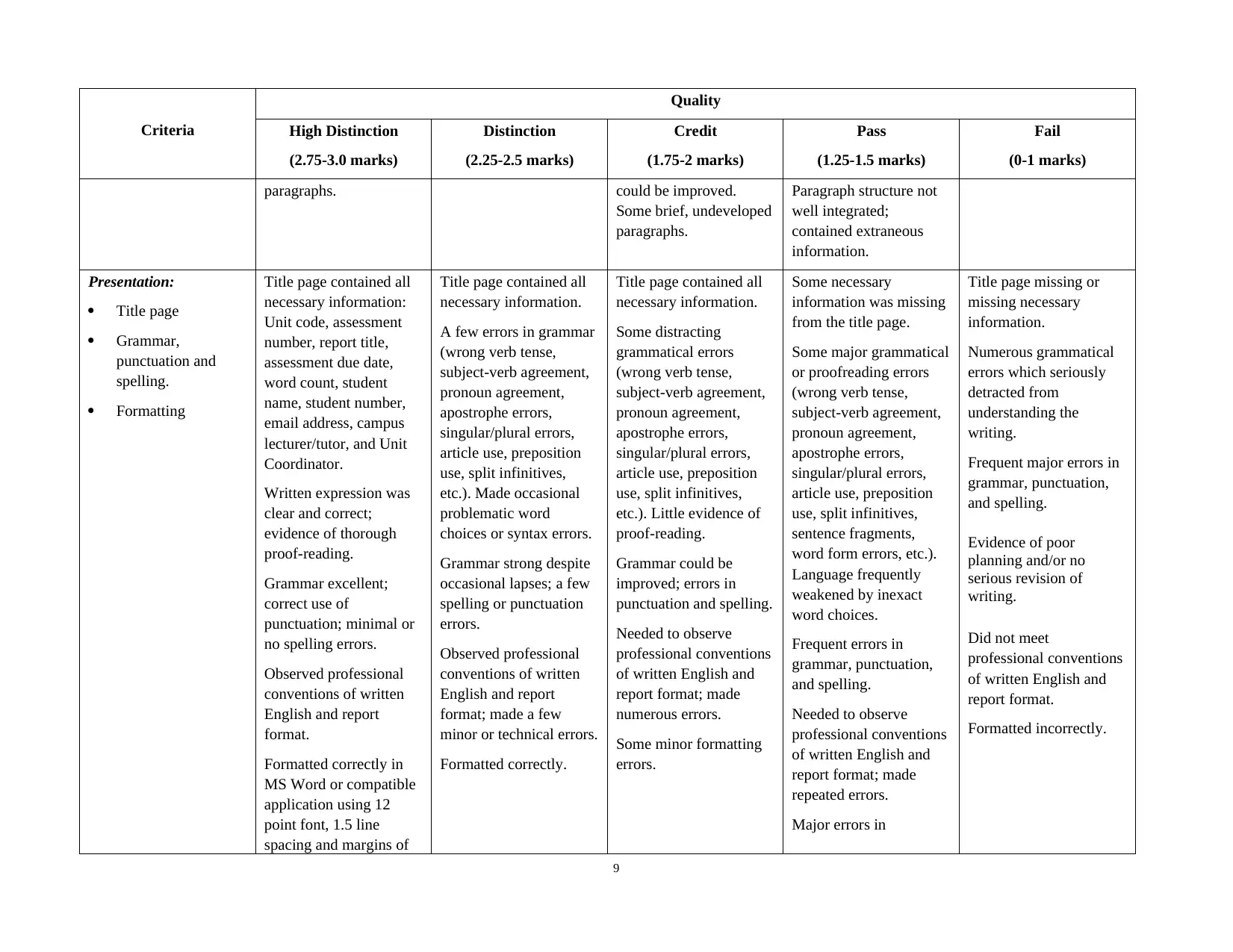
Criteria
Quality
High Distinction
(2.75-3.0 marks)
Distinction
(2.25-2.5 marks)
Credit
(1.75-2 marks)
Pass
(1.25-1.5 marks)
Fail
(0-1 marks)
paragraphs. could be improved.
Some brief, undeveloped
paragraphs.
Paragraph structure not
well integrated;
contained extraneous
information.
Presentation:
Title page
Grammar,
punctuation and
spelling.
Formatting
Title page contained all
necessary information:
Unit code, assessment
number, report title,
assessment due date,
word count, student
name, student number,
email address, campus
lecturer/tutor, and Unit
Coordinator.
Written expression was
clear and correct;
evidence of thorough
proof-reading.
Grammar excellent;
correct use of
punctuation; minimal or
no spelling errors.
Observed professional
conventions of written
English and report
format.
Formatted correctly in
MS Word or compatible
application using 12
point font, 1.5 line
spacing and margins of
Title page contained all
necessary information.
A few errors in grammar
(wrong verb tense,
subject-verb agreement,
pronoun agreement,
apostrophe errors,
singular/plural errors,
article use, preposition
use, split infinitives,
etc.). Made occasional
problematic word
choices or syntax errors.
Grammar strong despite
occasional lapses; a few
spelling or punctuation
errors.
Observed professional
conventions of written
English and report
format; made a few
minor or technical errors.
Formatted correctly.
Title page contained all
necessary information.
Some distracting
grammatical errors
(wrong verb tense,
subject-verb agreement,
pronoun agreement,
apostrophe errors,
singular/plural errors,
article use, preposition
use, split infinitives,
etc.). Little evidence of
proof-reading.
Grammar could be
improved; errors in
punctuation and spelling.
Needed to observe
professional conventions
of written English and
report format; made
numerous errors.
Some minor formatting
errors.
Some necessary
information was missing
from the title page.
Some major grammatical
or proofreading errors
(wrong verb tense,
subject-verb agreement,
pronoun agreement,
apostrophe errors,
singular/plural errors,
article use, preposition
use, split infinitives,
sentence fragments,
word form errors, etc.).
Language frequently
weakened by inexact
word choices.
Frequent errors in
grammar, punctuation,
and spelling.
Needed to observe
professional conventions
of written English and
report format; made
repeated errors.
Major errors in
Title page missing or
missing necessary
information.
Numerous grammatical
errors which seriously
detracted from
understanding the
writing.
Frequent major errors in
grammar, punctuation,
and spelling.
Evidence of poor
planning and/or no
serious revision of
writing.
Did not meet
professional conventions
of written English and
report format.
Formatted incorrectly.
9
Quality
High Distinction
(2.75-3.0 marks)
Distinction
(2.25-2.5 marks)
Credit
(1.75-2 marks)
Pass
(1.25-1.5 marks)
Fail
(0-1 marks)
paragraphs. could be improved.
Some brief, undeveloped
paragraphs.
Paragraph structure not
well integrated;
contained extraneous
information.
Presentation:
Title page
Grammar,
punctuation and
spelling.
Formatting
Title page contained all
necessary information:
Unit code, assessment
number, report title,
assessment due date,
word count, student
name, student number,
email address, campus
lecturer/tutor, and Unit
Coordinator.
Written expression was
clear and correct;
evidence of thorough
proof-reading.
Grammar excellent;
correct use of
punctuation; minimal or
no spelling errors.
Observed professional
conventions of written
English and report
format.
Formatted correctly in
MS Word or compatible
application using 12
point font, 1.5 line
spacing and margins of
Title page contained all
necessary information.
A few errors in grammar
(wrong verb tense,
subject-verb agreement,
pronoun agreement,
apostrophe errors,
singular/plural errors,
article use, preposition
use, split infinitives,
etc.). Made occasional
problematic word
choices or syntax errors.
Grammar strong despite
occasional lapses; a few
spelling or punctuation
errors.
Observed professional
conventions of written
English and report
format; made a few
minor or technical errors.
Formatted correctly.
Title page contained all
necessary information.
Some distracting
grammatical errors
(wrong verb tense,
subject-verb agreement,
pronoun agreement,
apostrophe errors,
singular/plural errors,
article use, preposition
use, split infinitives,
etc.). Little evidence of
proof-reading.
Grammar could be
improved; errors in
punctuation and spelling.
Needed to observe
professional conventions
of written English and
report format; made
numerous errors.
Some minor formatting
errors.
Some necessary
information was missing
from the title page.
Some major grammatical
or proofreading errors
(wrong verb tense,
subject-verb agreement,
pronoun agreement,
apostrophe errors,
singular/plural errors,
article use, preposition
use, split infinitives,
sentence fragments,
word form errors, etc.).
Language frequently
weakened by inexact
word choices.
Frequent errors in
grammar, punctuation,
and spelling.
Needed to observe
professional conventions
of written English and
report format; made
repeated errors.
Major errors in
Title page missing or
missing necessary
information.
Numerous grammatical
errors which seriously
detracted from
understanding the
writing.
Frequent major errors in
grammar, punctuation,
and spelling.
Evidence of poor
planning and/or no
serious revision of
writing.
Did not meet
professional conventions
of written English and
report format.
Formatted incorrectly.
9
⊘ This is a preview!⊘
Do you want full access?
Subscribe today to unlock all pages.

Trusted by 1+ million students worldwide
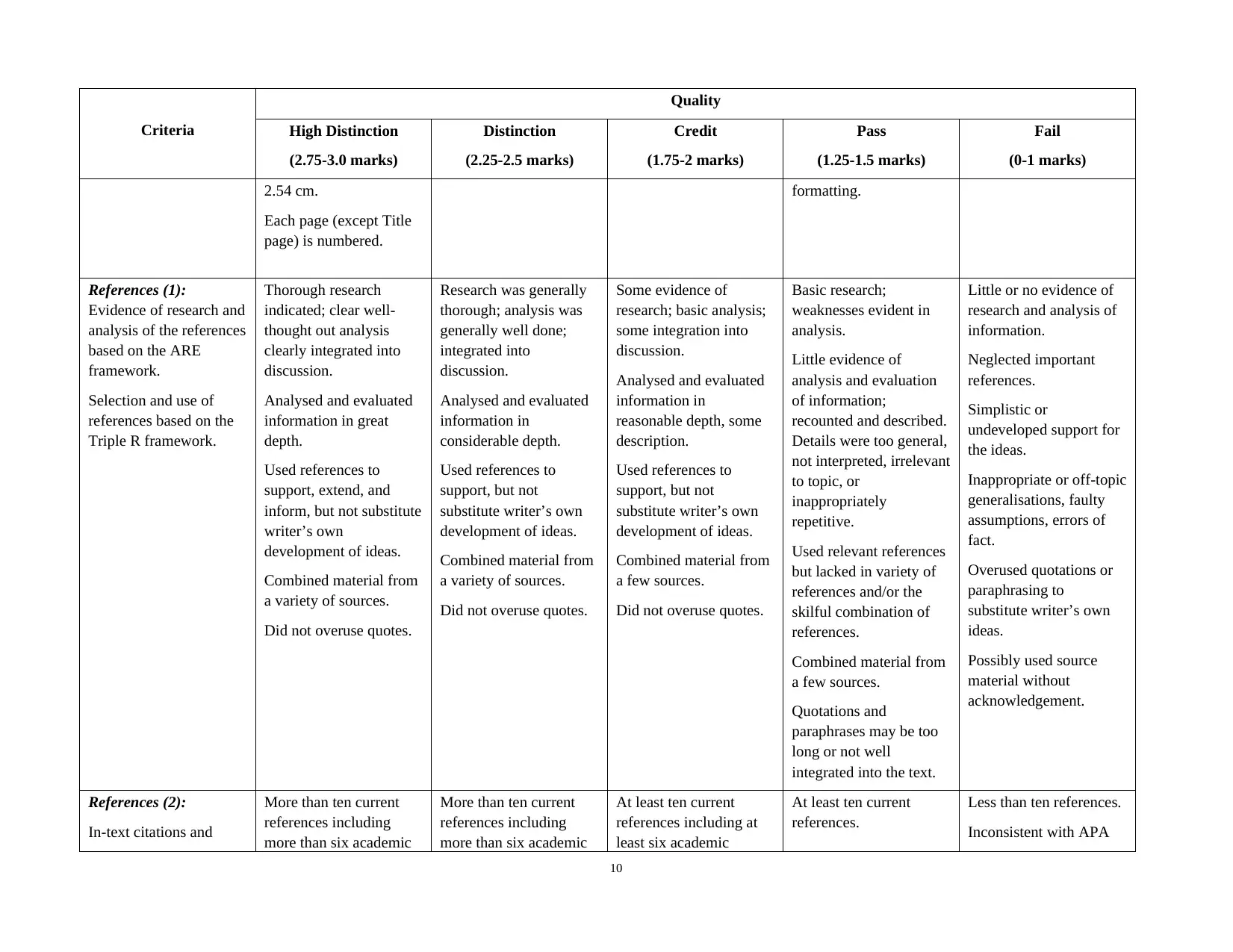
Criteria
Quality
High Distinction
(2.75-3.0 marks)
Distinction
(2.25-2.5 marks)
Credit
(1.75-2 marks)
Pass
(1.25-1.5 marks)
Fail
(0-1 marks)
2.54 cm.
Each page (except Title
page) is numbered.
formatting.
References (1):
Evidence of research and
analysis of the references
based on the ARE
framework.
Selection and use of
references based on the
Triple R framework.
Thorough research
indicated; clear well-
thought out analysis
clearly integrated into
discussion.
Analysed and evaluated
information in great
depth.
Used references to
support, extend, and
inform, but not substitute
writer’s own
development of ideas.
Combined material from
a variety of sources.
Did not overuse quotes.
Research was generally
thorough; analysis was
generally well done;
integrated into
discussion.
Analysed and evaluated
information in
considerable depth.
Used references to
support, but not
substitute writer’s own
development of ideas.
Combined material from
a variety of sources.
Did not overuse quotes.
Some evidence of
research; basic analysis;
some integration into
discussion.
Analysed and evaluated
information in
reasonable depth, some
description.
Used references to
support, but not
substitute writer’s own
development of ideas.
Combined material from
a few sources.
Did not overuse quotes.
Basic research;
weaknesses evident in
analysis.
Little evidence of
analysis and evaluation
of information;
recounted and described.
Details were too general,
not interpreted, irrelevant
to topic, or
inappropriately
repetitive.
Used relevant references
but lacked in variety of
references and/or the
skilful combination of
references.
Combined material from
a few sources.
Quotations and
paraphrases may be too
long or not well
integrated into the text.
Little or no evidence of
research and analysis of
information.
Neglected important
references.
Simplistic or
undeveloped support for
the ideas.
Inappropriate or off-topic
generalisations, faulty
assumptions, errors of
fact.
Overused quotations or
paraphrasing to
substitute writer’s own
ideas.
Possibly used source
material without
acknowledgement.
References (2):
In-text citations and
More than ten current
references including
more than six academic
More than ten current
references including
more than six academic
At least ten current
references including at
least six academic
At least ten current
references.
Less than ten references.
Inconsistent with APA
10
Quality
High Distinction
(2.75-3.0 marks)
Distinction
(2.25-2.5 marks)
Credit
(1.75-2 marks)
Pass
(1.25-1.5 marks)
Fail
(0-1 marks)
2.54 cm.
Each page (except Title
page) is numbered.
formatting.
References (1):
Evidence of research and
analysis of the references
based on the ARE
framework.
Selection and use of
references based on the
Triple R framework.
Thorough research
indicated; clear well-
thought out analysis
clearly integrated into
discussion.
Analysed and evaluated
information in great
depth.
Used references to
support, extend, and
inform, but not substitute
writer’s own
development of ideas.
Combined material from
a variety of sources.
Did not overuse quotes.
Research was generally
thorough; analysis was
generally well done;
integrated into
discussion.
Analysed and evaluated
information in
considerable depth.
Used references to
support, but not
substitute writer’s own
development of ideas.
Combined material from
a variety of sources.
Did not overuse quotes.
Some evidence of
research; basic analysis;
some integration into
discussion.
Analysed and evaluated
information in
reasonable depth, some
description.
Used references to
support, but not
substitute writer’s own
development of ideas.
Combined material from
a few sources.
Did not overuse quotes.
Basic research;
weaknesses evident in
analysis.
Little evidence of
analysis and evaluation
of information;
recounted and described.
Details were too general,
not interpreted, irrelevant
to topic, or
inappropriately
repetitive.
Used relevant references
but lacked in variety of
references and/or the
skilful combination of
references.
Combined material from
a few sources.
Quotations and
paraphrases may be too
long or not well
integrated into the text.
Little or no evidence of
research and analysis of
information.
Neglected important
references.
Simplistic or
undeveloped support for
the ideas.
Inappropriate or off-topic
generalisations, faulty
assumptions, errors of
fact.
Overused quotations or
paraphrasing to
substitute writer’s own
ideas.
Possibly used source
material without
acknowledgement.
References (2):
In-text citations and
More than ten current
references including
more than six academic
More than ten current
references including
more than six academic
At least ten current
references including at
least six academic
At least ten current
references.
Less than ten references.
Inconsistent with APA
10
Paraphrase This Document
Need a fresh take? Get an instant paraphrase of this document with our AI Paraphraser
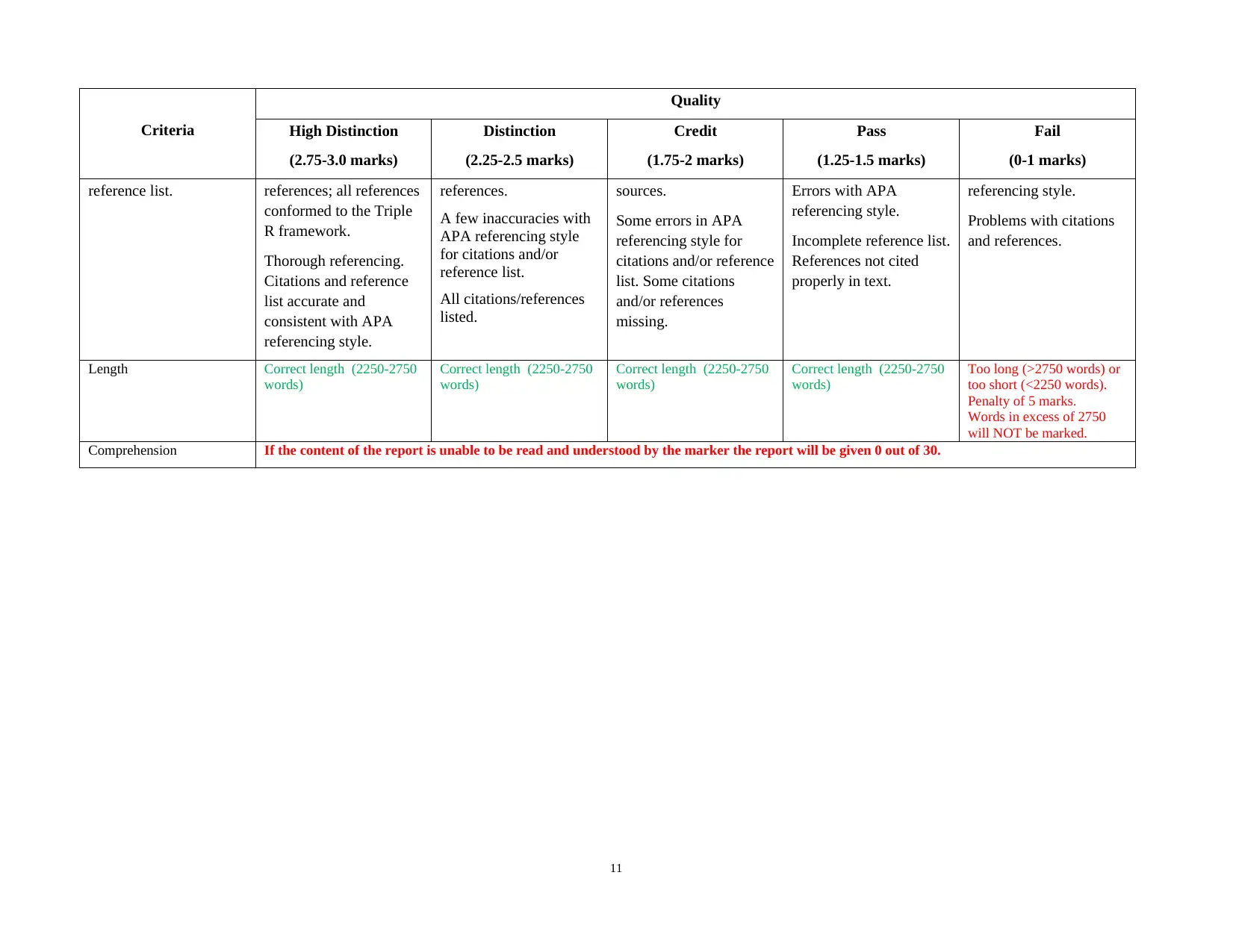
Criteria
Quality
High Distinction
(2.75-3.0 marks)
Distinction
(2.25-2.5 marks)
Credit
(1.75-2 marks)
Pass
(1.25-1.5 marks)
Fail
(0-1 marks)
reference list. references; all references
conformed to the Triple
R framework.
Thorough referencing.
Citations and reference
list accurate and
consistent with APA
referencing style.
references.
A few inaccuracies with
APA referencing style
for citations and/or
reference list.
All citations/references
listed.
sources.
Some errors in APA
referencing style for
citations and/or reference
list. Some citations
and/or references
missing.
Errors with APA
referencing style.
Incomplete reference list.
References not cited
properly in text.
referencing style.
Problems with citations
and references.
Length Correct length (2250-2750
words)
Correct length (2250-2750
words)
Correct length (2250-2750
words)
Correct length (2250-2750
words)
Too long (>2750 words) or
too short (<2250 words).
Penalty of 5 marks.
Words in excess of 2750
will NOT be marked.
Comprehension If the content of the report is unable to be read and understood by the marker the report will be given 0 out of 30.
11
Quality
High Distinction
(2.75-3.0 marks)
Distinction
(2.25-2.5 marks)
Credit
(1.75-2 marks)
Pass
(1.25-1.5 marks)
Fail
(0-1 marks)
reference list. references; all references
conformed to the Triple
R framework.
Thorough referencing.
Citations and reference
list accurate and
consistent with APA
referencing style.
references.
A few inaccuracies with
APA referencing style
for citations and/or
reference list.
All citations/references
listed.
sources.
Some errors in APA
referencing style for
citations and/or reference
list. Some citations
and/or references
missing.
Errors with APA
referencing style.
Incomplete reference list.
References not cited
properly in text.
referencing style.
Problems with citations
and references.
Length Correct length (2250-2750
words)
Correct length (2250-2750
words)
Correct length (2250-2750
words)
Correct length (2250-2750
words)
Too long (>2750 words) or
too short (<2250 words).
Penalty of 5 marks.
Words in excess of 2750
will NOT be marked.
Comprehension If the content of the report is unable to be read and understood by the marker the report will be given 0 out of 30.
11
1 out of 11
Related Documents
Your All-in-One AI-Powered Toolkit for Academic Success.
+13062052269
info@desklib.com
Available 24*7 on WhatsApp / Email
![[object Object]](/_next/static/media/star-bottom.7253800d.svg)
Unlock your academic potential
Copyright © 2020–2025 A2Z Services. All Rights Reserved. Developed and managed by ZUCOL.





